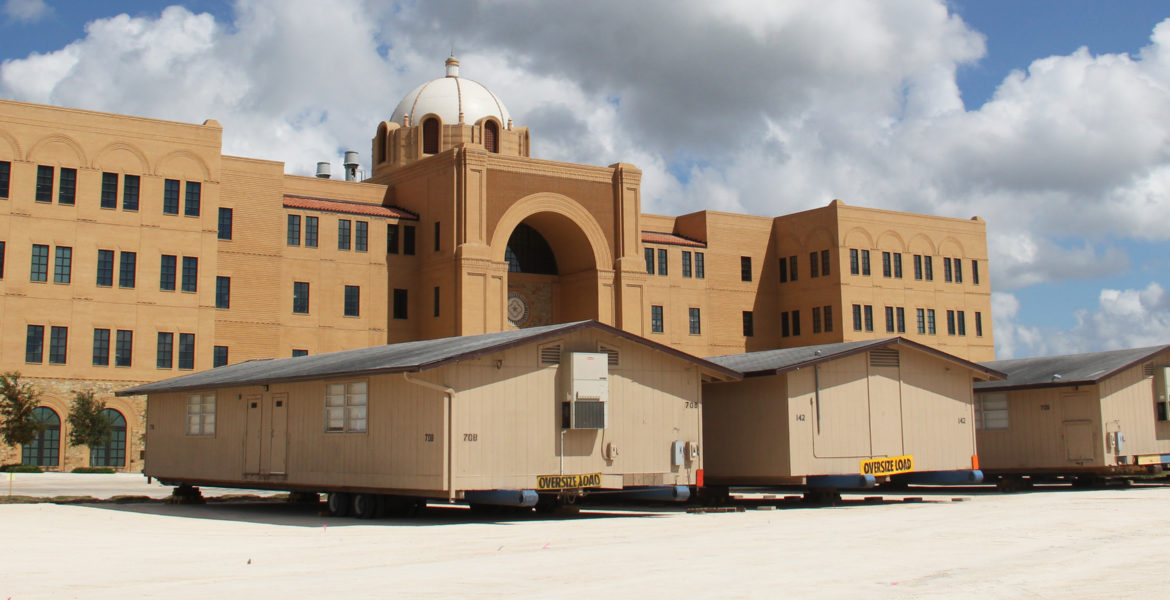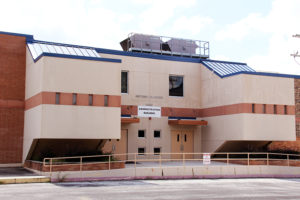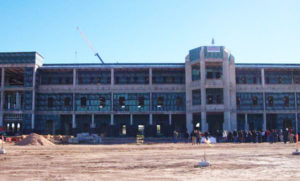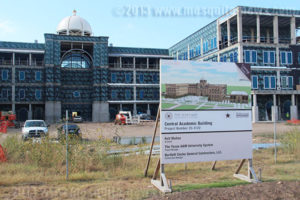Responding to Change

Portables being set behind Main Campus to bring business students over from Brooks City Base. Evolution of Esperanza Hall next to the Patriots Casa.
The Texas A&M University System was created by the Texas Legislature in 1948 to manage the development of a statewide educational, research and service system. A&M-San Antonio, one of the most recent members, earned recognition as the fastest growing within the system.
In 2009, the university became a stand-alone institution resulting in an enrollment spike. This fueled ambitious goals for Texas A&M-San Antonio to enroll more than 8,000 students by 2020.
Since then, the university has undergone major growth and changes in leadership. The hiring of a new president, provost and chief financial officer between 2014-16 impacted the direction of the university’s master plan for aggressive growth.
A&M-San Antonio leaders say they are excited for the anticipated growth, but is the campus prepared for the long-term changes that lie ahead?
Let’s take a look.
Development of a campus master plan
On Sept. 19, students gathered in the auditorium to attend a town hall style meeting with VisSpiro, the firm hired to design A&M-San Antonio’s master plan.
Chris Rice, one of VisSpiro’s professional planners, presented a campus growth plan through 12,500 students. He followed with a long-range master plan including renderings of future infrastructure.
“There has been tremendous growth in our student population, as it continues to grow we have to plan for that exponential growth,” said Arturo Alonzo, then the interim vice president for Business Affairs.
Projections place 6,600 students on campus by Fall 2018. But according to Jane Mims, director of Institutional Research, enrollment could increase as it did in Fall 2016. Growth patterns show student learners will arrive faster than the permanent buildings that will house them.
[metaslider id=24789]
As part of our exploration of where the university is headed, we begin with a look back on the expansive growth that began in the portable buildings on Palo Alto Campus in the southern sector of San Antonio.
Growing pains
 Before Texas A&M University-San Antonio became a short scenic drive down University Way, the system center was operating out of a group of portables located in Palo Alto College’s parking lot. Upper-division (junior and senior) students were attending classes in what used to be an alternative school located off Gillette Boulevard.
Before Texas A&M University-San Antonio became a short scenic drive down University Way, the system center was operating out of a group of portables located in Palo Alto College’s parking lot. Upper-division (junior and senior) students were attending classes in what used to be an alternative school located off Gillette Boulevard.
In Fall 2000, Texas A&M-San Antonio accepted its first class of upper-division students, a total enrollment of 126 students and only seven academic programs.
For seven years, the campus grew within the boundaries of Palo Alto College and the leased alternative school, until 2007, when Verano Land Group donated nearly 700 acres of abandoned farmland on the South Side of San Antonio.
With a supportive student body and new land to expand on, the only thing missing was funding.
Texas Lawmakers previously set aside $40 million worth of revenue bonds designated for a new Texas A&M-San Antonio campus. The school received the bonds on one condition; full-time enrollment of at least 1,500 students for each semester following.
Full-time enrollment was only 626 junior and senior students as of spring 2008.
Inaugural president of A&M-San Antonio Maria Hernandez Ferrier strategized to double full-time enrollment over summer 2008 break. This meant Ferrier’s goal was to increase the full-time student body by more than 874 students in just three months.
However, during Fall Term 2008, part-time and full-time enrollment totaled a mere 1,447 students.
In Fall 2008, Governor Rick Perry signed Senate Bill 629 declaring Texas A&M University-San Antonio a stand-alone university. The bill stated that the university could operate as a general institution once enrollment reached 1,000 full-time students for a single semester.
In one year, enrollment increased by 62 percent totaling 2,343 upper-division students.
Two years later in Fall Term 2011, the university completed Frank Madla Building finished construction and was ready to host classes for some of the 3,500 incoming Fall students. The Brooks City-Base Campus opened the College of Business and the Department of Counseling and Leadership.


Now in Fall 2016, Texas A&M-University San Antonio stands out because of its extremely diverse population and impressive growth rate. Woman make up 66 percent of students, 67 percent of the student body identify as Hispanic, 57 percent of students are the first in their family to attend college and almost 18 percent of students identify as part of the military community.
Since becoming a stand-alone institution in 2009, the university has grown from 2,343 students to 5,511 students, a 135 percent increase in enrollment.
Administration announced in summer 2016 that portables would be placed behind the Central Academic Building to house all classrooms the university will lose when relocating the Brooks City-Base Campus.
Construction for the first-ever residence hall, Esperanza Hall began fall 2016 and is expected to open for incoming Fall 2017 freshman and sophomores.
The Science, Technology, Engineering and Math, or STEM building, will break ground for construction Spring 2017.
“We hope to go to the Board of Regents for approval (of STEM Building) in February 2017 and hopefully will break ground in March or April with a hard hat completion date of Fall 2018,” Alonzo said.
[metaslider id=24798]
Most infrastructure growth at the university will depend directly on enrollment growth. The more students, the more resources the university will likely obtain. The state’s formula funding model, driven by credit hours taken by students, determine the ratio of funding from the Texas Legislature to build additional academic buildings and student support services.
Looking ahead
Expecting at least 8,100 Students for Fall 2020, the university has a number of considerations regarding expansion.
“There are projections of what will happen to our city as we grow on the South Side and how climate change is going to affect the impact that your concrete versus green footprint has on the quality of life that you’re going to have here,” said Professor Valdez, assistant professor of biology. “So this is important when we think about, in 20 years what do you want to see?”
Conserving vegetation, wildlife and other natural resources located in the 694 acres A&M-San Antonio sits on is a main priority. Climate change, protecting waterways and community planning also peak interest when discussing the growth of the university and community.
Multiple developers, environmentalists and advocates for the South Side community have to work together to create the perfect master plan for the university to be integrated seamlessly into the already existing environment.
Just how sustainable is the infrastructure growth plan regarding the conservation of Texas A&M-San Antonio’s 694 acres?
In the following articles, our reporting team interviews environmental specialists, community members, and architects to explore the repercussions, growth and direction of the university.
